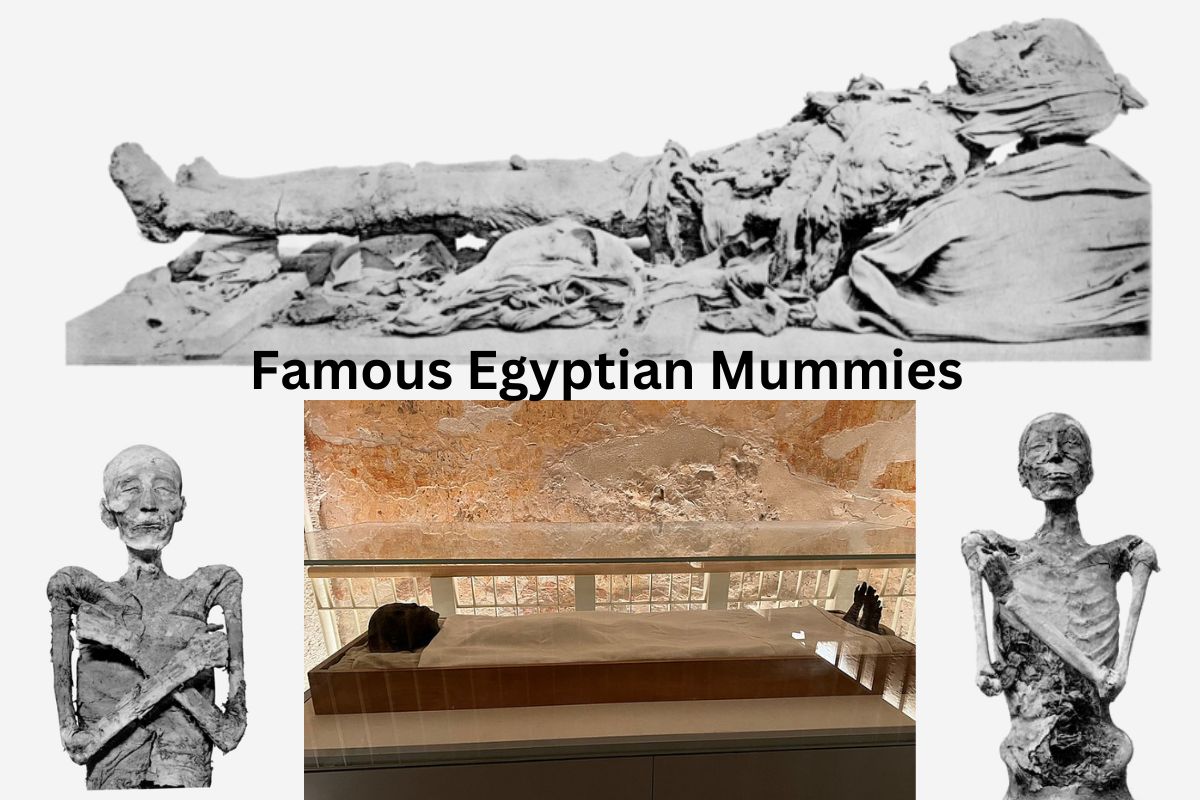Egyptian mummies have long piqued the interest of people all around the world, as they provide insight into the life and beliefs of ancient Egyptians.
Several of these mummies belonged to pharaohs, queens, and other significant characters, and they were preserved for thousands of years through rigorous embalming and burial procedures.
Tutankhamun, Ramses II, Cleopatra, and others are among the most renowned Egyptian mummies. These mummies have been the subject of significant study and inquiry because they reveal important information about ancient Egyptian history, culture, and religion.
These mummies continue to captivate our imaginations and evoke amazement and wonder, despite the passage of time.
Egyptian mummies are a tribute to the brilliance and cunning of one of the world’s oldest and most fascinating civilizations, from the meticulous wrappings and gorgeous adornments to the mysteries that still surround them.
Famous Egyptian Mummies
1. Tutankhamun
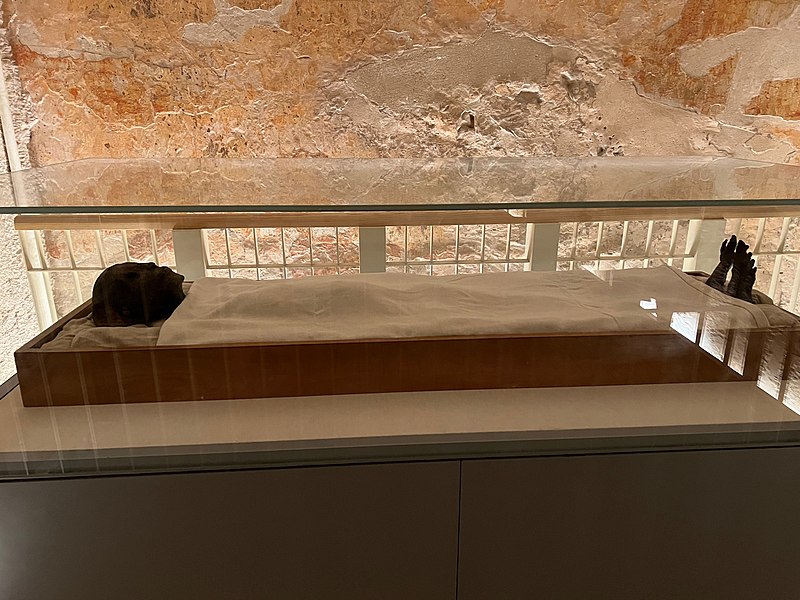
Tutankhamun’s mummy, popularly known as King Tut, was discovered in Egypt’s Valley of the Kings in 1922 by archaeologist Howard Carter. The mummy was discovered within a sarcophagus in his tomb’s burial chamber, which had been virtually undisturbed for almost 3,000 years.
Tutankhamun was an 18th dynasty pharaoh who reigned from around 1332 to 1323 BC. He is well known for his opulent tomb and the artifacts unearthed within it, including his famous golden mask.
Also Read: Famous Egyptian Pyramids
Tutankhamun’s mummy was well-preserved, and it revealed important details about his physical appearance and health. He was discovered to be about 5 feet 6 inches tall and roughly 18 years old when he died. His body was decked with jewelry and amulets, and his face was hidden behind a solid gold funeral mask.
Tutankhamun’s mummy was examined, and it was discovered that he had many physical defects and health issues, including a cleft palate and a clubfoot. He also suffered a fractured left thigh bone, which may have led to his death.
Also Read: Famous Egyptian Artifacts
Tutankhamun’s mummy is presently protected from harm and decomposition in the Valley of the Kings in Luxor, Egypt, in a climate-controlled glass exhibit. While the body is not on exhibit, visitors can see a copy of the tomb and some of the items discovered inside it at Cairo’s Egyptian Museum.
2. Ramses II

The mummy of Ramses II, commonly known as Ramses the Great, was discovered at the Deir el-Bahri cache in 1881, together with the bones of many New Kingdom pharaohs. Ramses II was a 19th dynasty pharaoh who reigned from roughly 1279 to 1213 BC.
Ramses II was noted for his military expeditions and architectural efforts, which included the construction of various temples and monuments around Egypt, notably the famous Abu Simbel temple complex. During his reign, he also had over 100 offspring and various spouses and consorts.
Also Read: Famous Egyptian Tombs
Although being transported multiple times over the ages, Ramses II’s mummy was in relatively decent condition. His body was decked with amulets and jewels, and his face was hidden behind a funeral mask composed of gold and other costly materials.
Ramses II’s mummy was relocated to the Egyptian Museum in Cairo in the 1970s, where it underwent intensive restoration and conservation treatment.
Also Read: Facts About Mummies
The mummy was relocated in 2003 to the Great Egyptian Museum in Cairo, where it is now on display in a specially engineered climate-controlled enclosure that helps to preserve it for future generations.
The mummy of Ramses II is one of the most important archaeological discoveries of all time, providing crucial insights into ancient Egyptian culture and history.
3. Hatshepsut
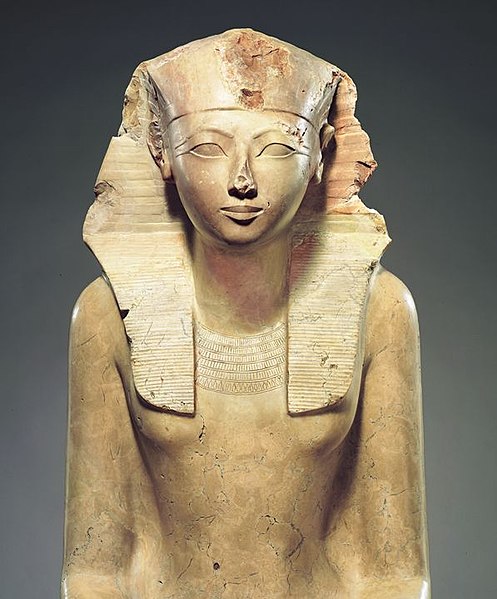
Hatshepsut’s mummy, one of ancient Egypt’s few female pharaohs, has never been positively identified. Despite numerous investigations and excavations, the exact place of her burial and the fate of her mummies are unclear.
Hatshepsut governed Egypt as pharaoh from 1478 to 1458 BC, during the 18th dynasty. She was well-known for her construction efforts, notably the famed funerary temple at Deir el-Bahri, as well as her successful commerce excursions to the Land of Punt, which is now modern-day Somalia.
Thutmose III, Hatshepsut’s stepson and successor, attempted to remove her memory from history by demolishing many of her statues and monuments after her death. Her tomb is thought to have been vandalized and potentially repurposed by succeeding pharaohs.
In 1903, a French Egyptologist led by Victor Loret uncovered a hoard of mummies in the Valley of the Kings that contained numerous members of Hatshepsut’s family, including her father, Thutmose I, and her grandmother, Ahmose Nefertari. Nevertheless, Hatshepsut’s mummy was not discovered.
Numerous more expeditions have attempted to locate Hatshepsut’s mummy over the years, but none have been successful. A team of archaeologists stated in 2007 that they had unearthed a tooth fragment believed to be Hatshepsut’s, although more research is needed to corroborate this theory.
Hatshepsut remains a significant character in Egyptian history and one of the most accomplished and powerful Egyptian queens of all time, notwithstanding the mystery surrounding her mummy.
4. Seti I
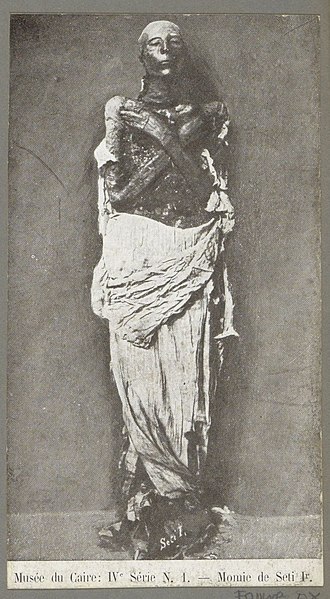
Seti I’s mummy, discovered in 1881 in the tomb of Amenhotep II in the Valley of the Kings, was an ancient Egyptian pharaoh who ruled during the 19th dynasty from roughly 1290 to 1279 BC. Seti I was noted for his military exploits and construction undertakings, especially the great temple of Abydos.
Seti I’s mummy was discovered in excellent condition, replete with jewelry and amulets. It was also unearthed with a wooden coffin and a stone sarcophagus that were both intricately adorned with hieroglyphics and scenes from Egyptian mythology.
Seti I’s mummy is now held in Cairo’s Egyptian Museum, where it is on exhibit for visitors to see. Over the years, the mummy has been subjected to a number of scientific examinations, including CT scans, which have assisted researchers in better understanding Seti I’s physical appearance, health, and cause of death.
According to these findings, Seti I was around 45 years old when he died, and he may have suffered from arthritis and other age-related health conditions. The actual cause of his death is unknown, however it is thought to have been natural.
Seti I’s mummy provides vital insights into ancient Egyptian society and history, and it is an important item for both historians and visitors.
5. Merneptah
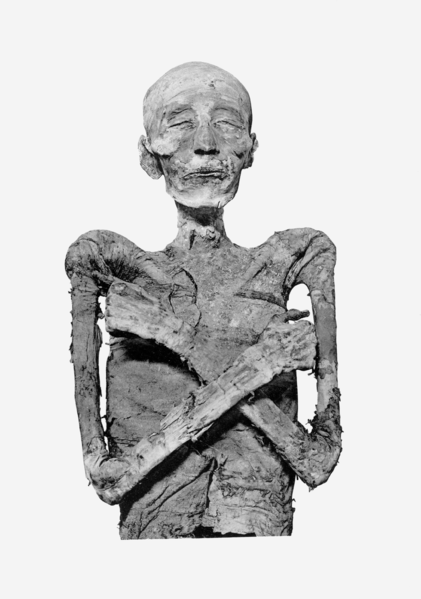
Merneptah’s mummy, discovered in 1904 in the tomb of Amenhotep II in the Valley of the Kings, was an ancient Egyptian pharaoh who ruled during the 19th dynasty from roughly 1213 to 1203 BC. Merneptah, Ramses II’s twelfth son, was notable for his military operations and building endeavors, particularly the mortuary temple at Thebes.
Merneptah’s mummy was discovered in a well-preserved state, replete with jewelry and amulets, including a pectoral necklace depicting the goddess Nut. The mummy was wrapped in linen before being placed in a wooden coffin, which was then placed into a stone sarcophagus.
Merneptah’s mummy is now housed in Cairo’s Egyptian Museum, where it is on exhibit for everyone to see. Over the years, the mummy has been subjected to a number of scientific tests, including CT scans, which have assisted researchers in better understanding Merneptah’s physical appearance, health, and cause of death.
According to these investigations, Merneptah was around 60 years old at the time of his death, and he may have had atherosclerosis, a condition that causes hardening and narrowing of the arteries. The actual cause of his death is unknown, however it is thought to have been natural.
Merneptah’s mummy provides unique insights into ancient Egyptian society and history, and it is an important item for both historians and visitors.
6. Amenhotep III
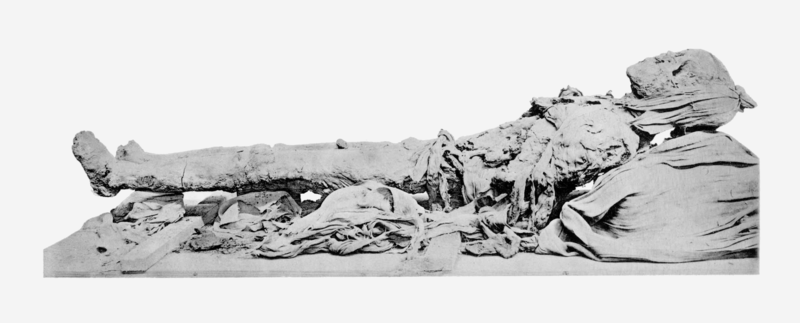
Amenhotep III’s mummy, discovered in 1898 in the tomb of Amenhotep II in the Valley of the Kings, was an ancient Egyptian pharaoh who ruled during the 18th dynasty from roughly 1386 to 1353 BC. Amenhotep III was well-known for his construction endeavors, which included the Luxor Temple and the Colossi of Memnon.
Also Read: Accomplishments of Amenhotep III
The mummy of Amenhotep III was discovered in a well-preserved form, replete with jewelry and amulets, including a massive gold funeral mask. The mummy was wrapped in linen and placed in a series of wooden coffins before being placed within a stone sarcophagus.
Amenhotep III’s mummy is now held at Cairo’s Egyptian Museum, where it is on exhibit for visitors to see. Many scientific tests, including CT scans and X-rays, have been conducted on the mummy throughout the years, allowing researchers to better comprehend Amenhotep III’s physical appearance, health, and cause of death.
According to these research, Amenhotep III was around 50 years old when he died, and he may have suffered from arthritis and other age-related health difficulties. The actual cause of his death is unknown, however it is thought to have been natural.
The mummy of Amenhotep III is an important item for scholars and visitors alike, providing unique insights into ancient Egyptian society and history.
7. Thutmose III
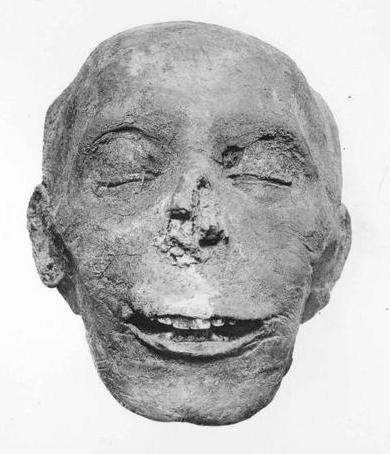
Thutmose III’s mummy, discovered alongside the remains of numerous other great pharaohs in the Valley of the Kings in 1881, was an ancient Egyptian pharaoh who ruled during the 18th dynasty from roughly 1479 to 1425 BC.
Thutmose III was noted for his military exploits, which aided in the expansion of Egypt’s frontiers and the establishment of Egypt’s power in the region.
Thutmose III’s mummy was discovered in excellent condition, and it was decked with jewelry and amulets, including a massive pectoral necklace depicting the goddess Hathor. The mummy was wrapped in linen and placed in a series of wooden coffins before being placed within a stone sarcophagus.
Also Read: Accomplishments of Thutmose III
Thutmose III’s mummy is now housed in Cairo’s Egyptian Museum, where it is on exhibit for everyone to see. Many scientific tests, including CT scans and X-rays, have been conducted on the mummy throughout the years, allowing researchers to better comprehend Thutmose III’s physical appearance, health, and cause of death.
According to these research, Thutmose III was around 50 years old when he died, and he may have suffered from arthritis and other age-related health difficulties. The actual cause of his death is unknown, however it is thought to have been natural.
The mummy of Thutmose III is an important item for historians and visitors alike, providing unique insights into ancient Egyptian culture and history.
8. Seti II

Seti II’s mummy, discovered in 1907 in the tomb of Amenhotep II in the Valley of the Kings, was an ancient Egyptian pharaoh who ruled during the 19th dynasty from around 1200 to 1194 BC. Seti II was Merneptah’s son and was notable for his construction endeavors, which included the construction of various temples and monuments around Egypt.
Seti II’s mummy was discovered in excellent condition, replete with jewelry and amulets. The mummy was wrapped in linen and placed in a series of wooden coffins before being placed within a stone sarcophagus.
Seti II’s mummy is now held in Cairo’s Egyptian Museum, where it is on exhibit for visitors to see. Over the years, the mummy has been subjected to a number of scientific examinations, including CT scans, which have assisted researchers in better understanding Seti II’s physical appearance, health, and cause of death.
According to these research, Seti II was between the ages of 35 and 40 at the time of his death, and he may have suffered from atherosclerosis, a condition that causes hardening and narrowing of the arteries. The actual cause of his death is unknown, however it is thought to have been natural.
Seti II’s mummy provides unique insights into ancient Egyptian society and history, and it is an important item for both historians and visitors.
9. Ramesses III
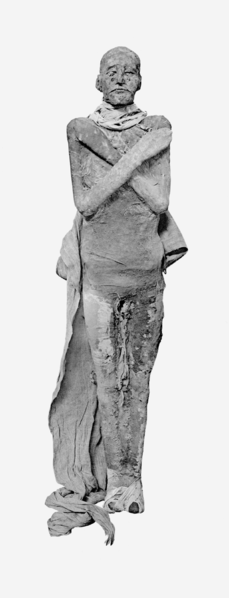
The mummy of Ramesses III, an ancient Egyptian pharaoh who ruled during the 20th dynasty from around 1186 to 1155 BC, was discovered in 1886 at the Deir el-Bahri tomb, which also housed the remains of other New Kingdom pharaohs. Ramesses III was well-known for his military expeditions and construction undertakings, which included the construction of various temples and monuments around Egypt.
The mummy of Ramesses III was discovered in a well-preserved form, replete with jewelry and amulets. The mummy was wrapped in linen and placed in a series of wooden coffins before being placed within a stone sarcophagus.
The mummy of Ramesses III is now housed in Cairo’s Egyptian Museum, where it can be seen by visitors. Many scientific tests, including CT scans, have been conducted on the mummy throughout the years, allowing scholars to better comprehend Ramesses III’s physical appearance, health, and cause of death.
According to these research, Ramesses III was around 60 years old when he died, and he may have suffered from arthritis and other age-related health difficulties. The specific reason of his death is unknown, however it is thought to have been the consequence of a harem conspiracy.
The mummy of Ramesses III is an important item for historians and visitors alike, providing unique insights into ancient Egyptian society and history.
